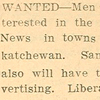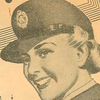Since the late 19th century newspapers and magazines have been a principal source of information, entertainment and advertising for Canadians. Both mediums currently face serious challenges in maintaining readership and advertising revenue, especially from competitors on the Internet.
Early 19th century newspapers were physically smaller and shorter then their later counterparts. Advertisements were printed but they were seldom more than a column wide and rarely illustrated. Subscription revenues and official and party patronage were still important sources of income.
In the last quarter of the century the invention of cheap wood pulp newsprint, typecasting machinery and cylinder presses permitted daily newspapers to greatly expand their circulations and their physical sizes. The expanded space now available for advertising was snapped up by manufacturers and retailers, who were attracted as well by an improved ability to incorporate images into newspaper ads. By 1900 most newspapers realized that their primary source of revenue lay not directly with their readers but with advertisers eager to reach them with commercial appeals.
This transformation in newspaper business models coincided with the settlement of the Canadian Northwest. Between 1891 and 1904 the number of newspapers on the prairies tripled and by 1905 there were fifty-two newspapers being produced in Saskatchewan. Despite the initial optimism of small town publishers it soon became difficult to sustain so many newspapers with such limited advertising revenue available.
There are three categories of newspaper advertisements. Classified ads are short text ads (usually two or three lines) typically submitted by individuals and small businesses when they have something to sell, swap, rent or repair. The advertiser is charged for the number of words or lines submitted. Most newspapers find classifieds a very lucrative source of revenue.
 The second type of newspaper advertising are camera ready display ads, of up to a full page format, placed by national or regional advertising agencies as part of campaigns by governments and corporations. The third type of newspaper ads are those solicited by the newspaper’s own sales staff, and often developed with the help of the paper's own copywriters and design staff. In a 1967 promotional booklet the Saskatoon StarPhoenix described these as “consumer education”, which it carried “to stimulate the community and foster a well-informed buying public.” The second type of newspaper advertising are camera ready display ads, of up to a full page format, placed by national or regional advertising agencies as part of campaigns by governments and corporations. The third type of newspaper ads are those solicited by the newspaper’s own sales staff, and often developed with the help of the paper's own copywriters and design staff. In a 1967 promotional booklet the Saskatoon StarPhoenix described these as “consumer education”, which it carried “to stimulate the community and foster a well-informed buying public.”
 Newspapers vary greatly in size, frequency and focus. Most familiar are dailies which may aim for a large local, regional or national readership. Advertisers regard daily newspapers as a good vehicle for reaching a large nonselective audience. Other newspapers focus their editorial efforts and advertising appeal to specific groups of readers, including farmers, business people and sports fans. During the past two decades there has been a rapid growth in the number of free weekly newspapers, supported entirely by advertising, that target niche population segments. The targeted markets include Indigenous people, youth, seniors, urban professionals, gays and lesbians and some recent immigrant communities. Newspapers vary greatly in size, frequency and focus. Most familiar are dailies which may aim for a large local, regional or national readership. Advertisers regard daily newspapers as a good vehicle for reaching a large nonselective audience. Other newspapers focus their editorial efforts and advertising appeal to specific groups of readers, including farmers, business people and sports fans. During the past two decades there has been a rapid growth in the number of free weekly newspapers, supported entirely by advertising, that target niche population segments. The targeted markets include Indigenous people, youth, seniors, urban professionals, gays and lesbians and some recent immigrant communities.
 Canadian produced magazines share many of the economic challenges of newspapers. Advertising dependent periodicals need to present their readerships as potentially lucrative markets. Magazines have historically highlighted their circulation figures emphasizing the qualities of their readership in terms of age, gender, education level, economic status, political allegiance and religious affiliation. Canadian produced magazines share many of the economic challenges of newspapers. Advertising dependent periodicals need to present their readerships as potentially lucrative markets. Magazines have historically highlighted their circulation figures emphasizing the qualities of their readership in terms of age, gender, education level, economic status, political allegiance and religious affiliation.
Among the most successful of Canadian magazines have been those directed to farmers and women. Attempts to produce Canadian magazines focusing on hobbies, entertainment, fashion, design and the interests of children and youth have been hindered by small market size and by competition from American and British magazines. Imported magazines can undercut the price of similar Canadian magazines since their editorial expenses can be spread over a much larger print run.
|






